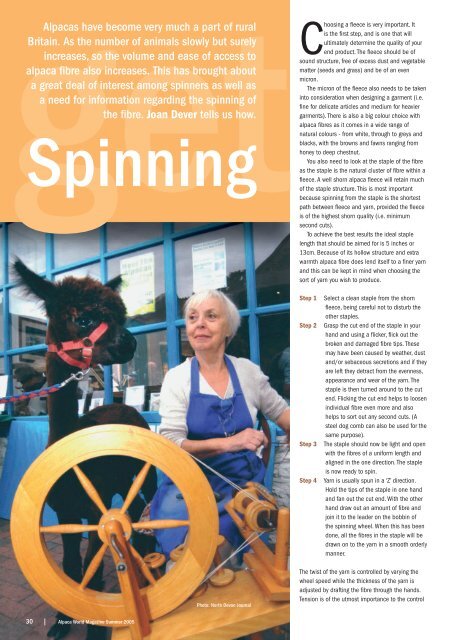Alpaca World Magazine Summer 2005 - Classical MileEnd Alpacas
Alpaca World Magazine Summer 2005 - Classical MileEnd Alpacas
Alpaca World Magazine Summer 2005 - Classical MileEnd Alpacas
- No tags were found...
Create successful ePaper yourself
Turn your PDF publications into a flip-book with our unique Google optimized e-Paper software.
<strong>Alpaca</strong>s have become very much a part of ruralBritain. As the number of animals slowly but surelyincreases, so the volume and ease of access toalpaca fi bre also increases. This has brought abouta great deal of interest among spinners as well asa need for information regarding the spinning ofthe fi bre. Joan Dever tells us how.SpinningChoosing a fl eece is very important. Itis the fi rst step, and is one that willultimately determine the quality of yourend product. The fl eece should be ofsound structure, free of excess dust and vegetablematter (seeds and grass) and be of an evenmicron.The micron of the fl eece also needs to be takeninto consideration when designing a garment (i.e.fi ne for delicate articles and medium for heaviergarments). There is also a big colour choice withalpaca fi bres as it comes in a wide range ofnatural colours - from white, through to greys andblacks, with the browns and fawns ranging fromhoney to deep chestnut.You also need to look at the staple of the fi breas the staple is the natural cluster of fi bre within afl eece. A well shorn alpaca fl eece will retain muchof the staple structure. This is most importantbecause spinning from the staple is the shortestpath between fl eece and yarn, provided the fl eeceis of the highest shorn quality (i.e. minimumsecond cuts).To achieve the best results the ideal staplelength that should be aimed for is 5 inches or13cm. Because of its hollow structure and extrawarmth alpaca fi bre does lend itself to a fi ner yarnand this can be kept in mind when choosing thesort of yarn you wish to produce.Step 1Step 2Step 3Step 4Select a clean staple from the shornfl eece, being careful not to disturb theother staples.Grasp the cut end of the staple in yourhand and using a fl icker, fl ick out thebroken and damaged fi bre tips. Thesemay have been caused by weather, dustand/or sebaceous secretions and if theyare left they detract from the evenness,appearance and wear of the yarn. Thestaple is then turned around to the cutend. Flicking the cut end helps to loosenindividual fi bre even more and alsohelps to sort out any second cuts. (Asteel dog comb can also be used for thesame purpose).The staple should now be light and openwith the fi bres of a uniform length andaligned in the one direction. The stapleis now ready to spin.Yarn is usually spun in a ‘Z’ direction.Hold the tips of the staple in one handand fan out the cut end. With the otherhand draw out an amount of fi bre andjoin it to the leader on the bobbin ofthe spinning wheel. When this has beendone, all the fi bres in the staple will bedrawn on to the yarn in a smooth orderlymanner.Photo: North Devon JournalThe twist of the yarn is controlled by varying thewheel speed while the thickness of the yarn isadjusted by drafting the fi bre through the hands.Tension is of the utmost importance to the control30 | <strong>Alpaca</strong> <strong>World</strong> <strong>Magazine</strong> <strong>Summer</strong> <strong>2005</strong>







